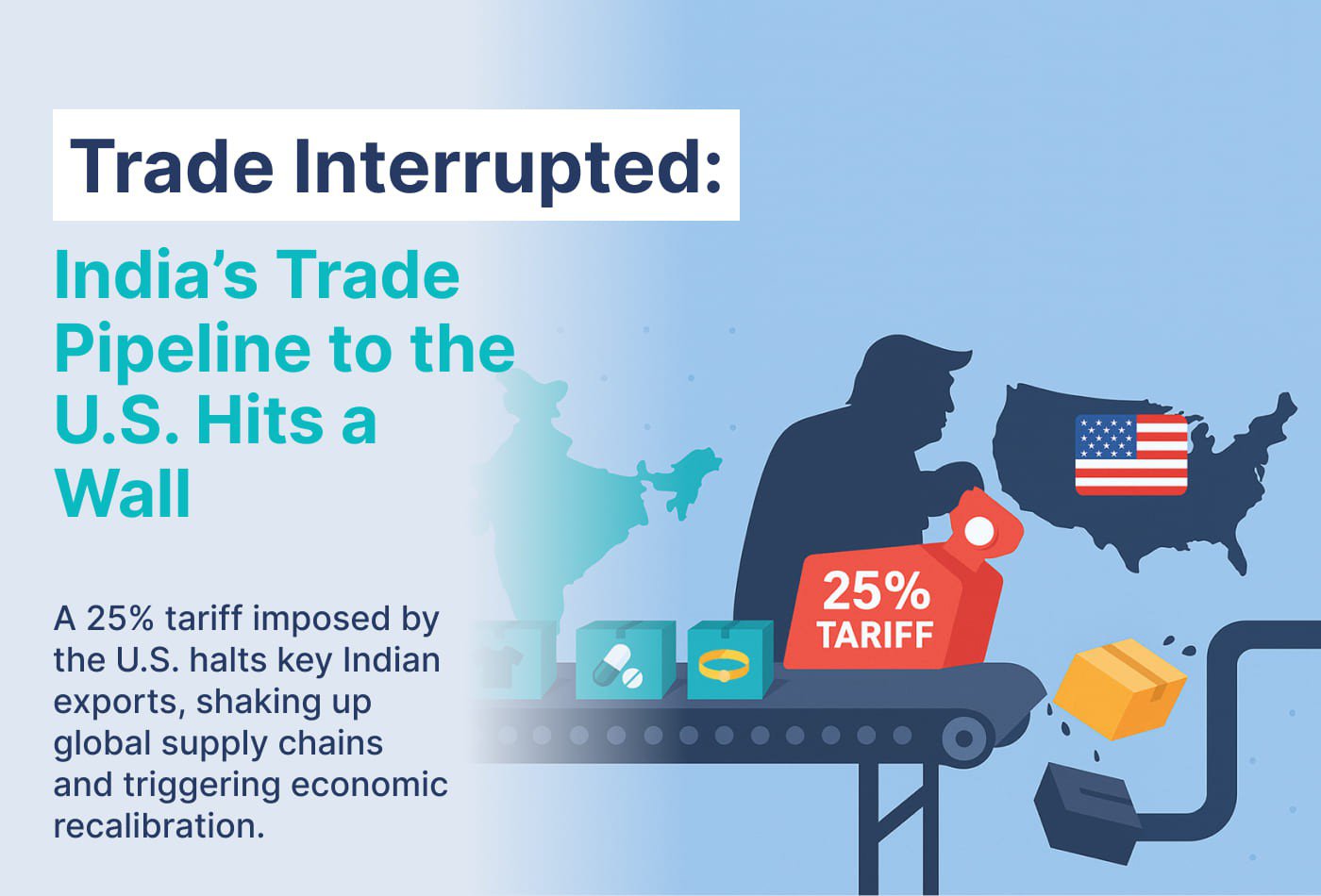
In a move that’s sent ripples across global trade, former U.S. President Donald Trump announced a 25% tariff on imports from India, effective August 7, 2025, along with an unspecified penalty. This marks a significant shift in Indo-U.S. trade dynamics and raises pressing questions for exporters, policymakers, and global investors.
While this announcement has reignited debates on protectionism, it also signals a period of strategic recalibration for India — one that could redefine its position in the global export landscape.
Why the Tariff? U.S. Rationale Behind the Move
The U.S. administration cites India’s continued purchase of crude oil and military equipment from Russia as a key reason behind the tariff and penalty. Labeling India’s trade policies as “non-reciprocal” and “excessively protectionist,” Trump called out India as one of the world’s “highest tariff nations.”
This move is part of a broader strategy targeting over 70 countries under an executive order aimed at realigning U.S. trade interests with its current foreign policy and security posture.
Impact on India: Sector-Wise Breakdown
1. Textiles & Garments
India’s textile industry — especially export giants like Welspun, Indocount, Trident, and Gokaldas Exports — stands directly in the firing line. Nearly 40–70% of their exports go to the U.S., and a sudden 25% hike in duties could price Indian goods out of the American market.
Vietnam and Bangladesh, already formidable competitors with lower labor costs and better U.S. trade terms, are expected to benefit from the diversion of orders.
2. Pharmaceuticals
The U.S. is India’s largest pharma market, with exports exceeding $8 billion annually. A tariff on generic medicines could:
- Increase U.S. drug prices, especially for life-saving medications.
- Affect large Indian exporters like Sun Pharma, Dr. Reddy’s, and Cipla.
However, Pharmexcil maintains that India’s pricing, reliability, and production scale give it a durable edge, and many believe pharma trade will eventually normalize.
3. Gems & Jewellery
India is a global hub for diamond cutting and gold jewellery exports. The U.S. accounts for over 30% of jewellery exports, especially from Gujarat and Maharashtra. A 25% tariff will likely:
- Shrink margins.
- Push U.S. buyers toward Thailand or China.
Industry associations have called for export subsidies and incentives to offset losses.
4. Chemicals, Ceramics & Auto Parts
These high-volume sectors face a dual hit: higher tariffs and dependence on low-margin exports.
- Companies like Bharat Forge and Sona Comstar in the auto parts segment may reevaluate U.S. shipments.
- Morbi-based ceramic exporters, already reeling from freight cost increases, now see their U.S. competitiveness under threat.
Macroeconomic Signals: Currency & Markets React
- The Indian Rupee dropped to ₹87.65/$, as foreign portfolio investors pulled out over $600 million in just two days.
- Indian equity markets saw pressure, especially on export-driven midcaps in textiles and pharma.
- Bond yields rose slightly, indicating investor caution.
These moves signal broader concern about India's current account and trade balance over the next two quarters.
India’s Response: Strategic but Cautious
Commerce Minister Piyush Goyal stated that India is “studying the implications” and remains committed to diplomatic channels and trade talks. While no retaliatory tariffs have been announced, behind-the-scenes efforts to restart the Indo-U.S. Trade Policy Forum (TPF) and revive FTA talks are reportedly underway. Indian exporters, particularly in MSME clusters of Ludhiana, Surat, and Tirupur, have urged the government to:
- Provide GST refunds faster.
- Expand RoDTEP (Remission of Duties and Taxes on Export Products) coverage.
- Offer financial relief or export-linked production incentives.
The Bigger Picture: Rebalancing Global Trade
Will India Lose Global Ground?
Not necessarily. While the U.S. tariff shock is significant, many experts suggest that it may:
- Accelerate India's diversification toward Europe, ASEAN, and Africa.
- Boost the "Make in India for the World" vision in the medium term.
- Encourage new bilateral trade deals (e.g., with the UK, EU, and UAE).
Final Word: Turning Challenge Into Opportunity
The 25% U.S. tariff is a wake-up call — but not a knockout punch.
India has weathered similar trade turbulence in the past, from the GSP withdrawal in 2019 to COVID-era logistic shocks. Each time, the economy adapted, diversified, and came back stronger.
With the right mix of policy agility, export incentives, and market diversification, India can not only mitigate this latest shock but reclaim its global edge in trade and manufacturing.





 Get instant quote
and compare offers in real time
Get instant quote
and compare offers in real time